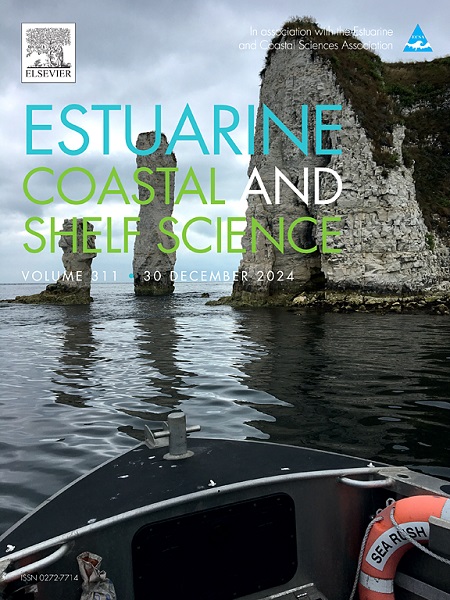海平面上升下盐沼生态系统服务的新权衡
IF 2.6
3区 地球科学
Q1 MARINE & FRESHWATER BIOLOGY
引用次数: 0
摘要
沿海湿地的海防和碳储存提供了一种日益得到认可的适应和减缓气候变化的手段,然而,这些服务也受到它们所保护的影响的威胁。迄今为止,我们的理解倾向于考虑海平面上升对个别沼泽服务的影响,但未能考虑它们之间的权衡和潜在的相互作用。例如,海平面上升有可能增加碳储量,但可能会造成次优生长条件,从而降低土壤稳定性、抗侵蚀能力和波浪衰减能力,导致植物变得更弱、更小。因此,我们的目标是回答这个问题:海平面上升会在盐沼碳储存和海岸防御之间产生单向影响,还是形成对比的“权衡”?我们进行了一项野外实验,在超过通常的英国米草生长的向海极限的淹没持续时间上,模拟在已建立的植被斑上的单反,并测量了:(1)碳分解率,(2)沉积物稳定性,(3)英国米草的生物力学特性,作为波浪衰减能力的代理。随着淹没时间的延长,碳分解速度减缓,支持了碳储存,因此对减缓气候变化产生了积极影响。相反,沉积物稳定性和植被刚度下降,从而对气候变化适应产生负面影响。我们的研究结果表明,气候生态系统服务与SLR之间存在短期的权衡关系,其中对碳储存的积极影响可能抵消对海防服务的负面影响。然而,由于较低的沉积物稳定性增加了极端事件下沼泽侵蚀的机会,随着时间的推移,这将增加沉积物再悬浮的可能性,并最终将先前储存的碳释放到海洋碳循环中。因此,生态系统服务之间的相互作用可能导致SLR对气候减缓服务的净负面影响。总体而言,我们强调了采取多服务方法来考虑全球变化对生态系统服务的影响的必要性。本文章由计算机程序翻译,如有差异,请以英文原文为准。

Emerging trade-offs in saltmarsh ecosystem services under sea-level rise
Coastal defence and carbon storage by coastal wetlands provide an increasingly recognised means of adaptation and mitigation in the face of climate change, yet these same services are threatened by the impacts against which they protect. Our understanding to date tends to consider impacts of rising sea levels on individual marsh services but fails to consider trade-offs and potential interactions between them. For instance, sea-level rise has the potential to enhance carbon storage but may decrease soil stability, erosion resistance and wave-attenuation capacity by creating sub-optimal growth conditions, causing plants to be weaker and smaller. As such, we aim to answer the question: will rising sea levels drive unidirectional impacts, or contrasting ‘trade-offs’, between saltmarsh carbon storage and coastal defence? We conducted a field experiment across increasing inundation durations beyond the usual seaward limit of Spartina anglica growth, mimicking SLR at established vegetation patches, and measured (1) carbon decomposition rates using the teabag index as proxy, (2) sediment stability, and (3) biomechanical traits of S.anglica as proxy for wave-attenuation capacity. With increasing inundation duration, rates of carbon decomposition slowed, supporting carbon storage, and therefore positively impacted climate change mitigation. In contrast, both sediment stability and vegetation stiffness decreased and hence negatively impacted climate change adaptation. Our findings point to a short-term trade-off in climate ecosystem services with SLR, where positive impacts on carbon storage may offset negative impacts on coastal defence services. However, since lower sediment stability increases the chance of marsh erosion under extreme events, this will increase over time the likelihood of sediment resuspension and the ultimate rerelease of previously stored carbon into the marine carbon cycle. Thus, the interaction between ecosystem services may lead to a net negative impact of SLR on climate mitigation services. Overall, we highlight the necessity of taking a multi-service approach to considering the impact of global change effects on ecosystem services.
求助全文
通过发布文献求助,成功后即可免费获取论文全文。
去求助
来源期刊
CiteScore
5.60
自引率
7.10%
发文量
374
审稿时长
9 months
期刊介绍:
Estuarine, Coastal and Shelf Science is an international multidisciplinary journal devoted to the analysis of saline water phenomena ranging from the outer edge of the continental shelf to the upper limits of the tidal zone. The journal provides a unique forum, unifying the multidisciplinary approaches to the study of the oceanography of estuaries, coastal zones, and continental shelf seas. It features original research papers, review papers and short communications treating such disciplines as zoology, botany, geology, sedimentology, physical oceanography.

 求助内容:
求助内容: 应助结果提醒方式:
应助结果提醒方式:


